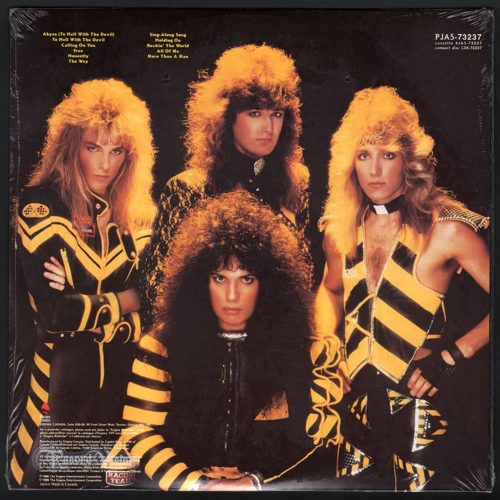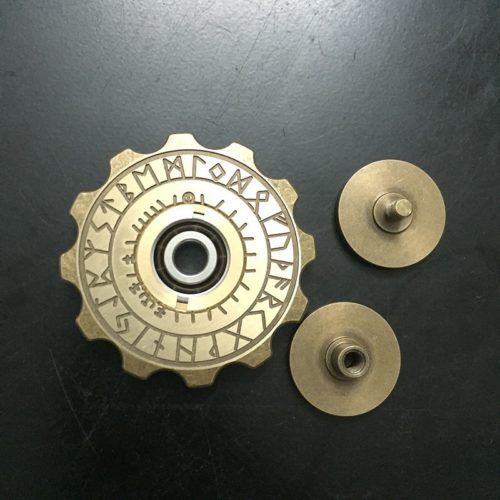![]()
Back in high school in the late 1980s, my friend Dan really liked the band Stryper. He cut the sleeves off his jean jacket, drew the band’s logo in Elmer’s glue on the back, then threw gold and black glitter at it to make the only Stryper vest any of us had ever seen. We teased him mercilessly.
Why? Because Stryper was a totally cheesy Christian glam metal band from Orange County that sang about Jesus while wearing mascara and yellow spandex, and that seemed the most un-metal thing possible to a bunch of teenage hippies and metal-heads in 1986. The band sold t-shirts that read “777, To Hell with the Devil” and sang lyrics like this:
Oh, what did you say?
Oh, Christ is the way!
Rockin’ for the One who is the Rock!I feel His strength come into me!
Reading His word helps me to see!
I feel so new, I want to sing!
Feeling His joy in everything!
The record featuring these catchy lyrics was the first Christian metal album to go platinum. This was exactly the kind of fervently faithful (and unintentionally homoerotic) corporate Christian rock that South Park would later mercilessly lampoon in their “Christian Rock Hard” episode.

Mascara and Roman collars: the back cover of Stryper’s To Hell with the Devil LP (1986)
Three decades after Dan made his Stryper vest, I found myself wearing commercially-produced Amon Amarth t-shirts with pictures of Odin on the front and odes to the Norse god on the back. Amon Amarth is a totally bad-ass melodic death metal band from Sweden that sings about Odin while wearing Thor’s hammers and Viking beards, and that is the most metal thing possible to a bunch of middle-aged dad-rockers in 2016. The band sells t-shirts that read “Thunder God, Master of War” and sings lyrics like this:
Fire! Burning in his eyes!
Fire! His hate is pure, see the lightning strike!Lightning cracks the blackened sky!
Hear the thunder chariot ride!
All brave men with hearts of war!
Ride the path of mighty Thor!
Is this really any less cheesy than what Stryper was doing in the 1980s? Is there a fundamental difference between rockin’ for Jesus and headbanging for Thor?
I’m not the only practicing Heathen with Amon Amarth t-shirts in his closet. There is a sizable subset of Heathens around the world that listens to metal bands that have built their lyrics and image around Norse Pagan themes, whether they are categorized as Viking metal, Pagan metal, folk metal, or something else. Are the Heathens who dig these bands fundamentally different than Christians who thought Stryper was totally awesome?
Johan Hegg, Amon Amarth’s vocalist, told me back in 2010 that his band embracing a Norse theme was “accidental from the start.” Only one of their early songs was about Norse mythology, but they went on to write many more on the same theme to great success on the metal scene. By the time I met him, Hegg seemed ready to move on to other lyrical topics, but said, “It’s at the point where it’s hard to change it, because people expect us to do it.” The band has released three studio albums since then, all about Ragnarök and Vikings.
Hegg also told me that, although some of his lyrics “are kind of preaching,” he is an atheist with an interest in Norse mythology as “a philosophical thing.” Heri Joensen of the band Tyr sells t-shirts with the Converse All-Star logo changed to Convert All-Pagan, yet he not only told me that he is an atheist, but – when I asked him why he had such a problem with his fans who were also Heathens – he said that their beliefs are “obviously not true. Having to explain that to adults, I think, is a waste of my good time.”
If the people writing, recording, and performing songs about practicing Heathenry are atheists with no interest in the modern religions, why are they so attractive to Heathens? Tyr actually has lost some Heathen support due to Joensen’s comments to me and on other outlets, but other bands continue to be popular with the practicing crowd.
Do the beliefs of the band matter? Maybe not, given that Black Sabbath was arguably a Catholic metal band that wrote a song supporting the pope (later covered by Stryper) and released an album cover (based on illustrations given to the creative director at his confirmation) contrasting the suffering of the sinner on the front with the bliss of the good Christian on the back, yet I have never heard of a non-Christian metal-head avoiding their music because of the band members’ Catholic worldview.

A Christian death among loved ones: Drew Struzan’s Sabbath Bloody Sabbath back cover art (1973)
Does the music produced and the image marketed matter? Hegg told me that, in rebelling against “the so-called standards and rules… made up by religion or religious people,” a band has to “take the opposite stand.” The stark opposition between Stryper singing about Christ’s “joy in everything” and Amon Amarth singing that Thor’s “hate is pure” is intentional. Ditto for Tyr’s album By the Light of Northern Star, which features both the anthemic “Hold the Heathen Hammer High” and a cover of a Viking chopping down a crucifix with his sword. At least for these bands, Heathenry is a vehicle for promoting atheism and anti-Christian ideology.
Is this something that should be attractive to Heathens? Turning Thor into a hateful anti-Christ and glorifying in the destruction of the sacred symbols of another faith seems more heathen (in the derogatory sense used by conservative Christians for all those outside their faith) than it does Heathen (in the positive sense used by practitioners of contemporary Germanic Paganism).
If we truly are our deeds, as many Heathens believe, is saluting a hateful god and celebrating violence towards infidels what we want to be doing? Metal musician, convicted murderer, church-burner, and “Pagan European” Varg Vikernes is no hero of mine, and his hateful views are no part of my religious beliefs.
At least the Stryper fans were celebrating a band that stayed true to the most basic positive aspects of the faith of their fans. Should we be promoting bands that themselves promote a cartoonish view of historical and contemporary Heathen religion that is almost exclusively about the bloodshed at Ragnarök and the violence of Viking raids? For the vast majority of Heathens today, this is not what their worldview is about.
The issue of Heathen swag goes beyond the metal subculture. For every young Christian wearing a WWJD (“What would Jesus do?”) bracelet in the 1990s, there’s an adult Heathen wearing a valknut pendant they bought on Amazon in the 2010s. For every evangelical girl who wore a purity ring then, there’s a Heathen woman with a shield-maiden from the Vikings TV show as her online avatar.
Aside from the cheese factor, do we really want to replicate the shallowest and most corporate elements of the late-1900s surge of evangelical pop culture? It’s one thing to craft your own jewelry or support Heathen artists, designers, crafters, and businesses. It’s another to wear cheap corporate hokum designed to cash in on the Viking fad in commercial pop culture as an expression of religious adherence.
Again, I’m as guilty as the next person. My first Thor’s hammer was in the shape it takes in the Marvel comics. My second was the same cheap pewter one many newbies start out with. I love Thor comics, but I’ve felt weird for a while about wearing Marvel Thor t-shirts, since I imagine people saying, “Oh, so you do worship a comic book character!” Of course I don’t, but appearances do matter, and we’re already dealing with a lot of misconceptions about Ásatrú and Heathenry.
The most recent impetus for this doubt and questioning was a runic fidget spinner. It is literally a fidget spinner covered in runes. In the Heathen Facebook group where I saw it posted, the universal response was “shut up and take my money!” I couldn’t help thinking of 1980s evangelicals who obsessively and compulsively put crucifixes on everything from key chains to conversion vans. Do we really have to have runes on everything?

Runes in motion: a Viking fidget spinner
As with the metal music, the cheese is coupled with violent Viking stereotypes. For awhile, targeted online advertising was peppering me with ads for the most tasteless tchotchkes “inspired by real Viking jewelry.” I don’t really need a pewter pimp-ring with a skull floating over a valknut or a set of dangly earrings featuring a pentagram inscribed onto Thor’s hammer, thanks.
Also, no, I would not like to purchase a baseball hat that says “ASATRU.” I would probably giggle-snort uncontrollably if I saw someone in a trucker hat that said “JUDAISM” or “MORMONISM.” Again, I humbly suggest that we all maybe consider not replicating the most cringe-worthy aspects of Reagan-era Christian fundamentalism.
If you want to wear a red plastic WWTS (“What would Thor smite?”) bracelet, more power to you. Right now, I’m wearing an old t-shirt for the Texan band the Sword that has Odin’s three (!) ravens on the front, because it’s totally metal. Let’s just be honest about how cheesy this all is, and maybe reflect a bit on whether we should be out in the world promoting the idea that Heathenry, divine hate, and Viking violence are integrally connected.
Given what’s going on in the United States these days, and given that some Heathens on the extreme fringe are cheering on the Nazis, maybe wearing your Thor’s hammer over that metal shirt with a bloody Viking bludgeoning someone to death isn’t the best fashion choice.
* * *
The views and opinions expressed by our diverse panel of columnists and guest writers represent the many diverging perspectives held within the global Pagan, Heathen and polytheist communities, but do not necessarily reflect the views of The Wild Hunt Inc. or its management.
The Wild Hunt is not responsible for links to external content.
To join a conversation on this post:
Visit our The Wild Hunt subreddit! Point your favorite browser to https://www.reddit.com/r/The_Wild_Hunt_News/, then click “JOIN”. Make sure to click the bell, too, to be notified of new articles posted to our subreddit.
